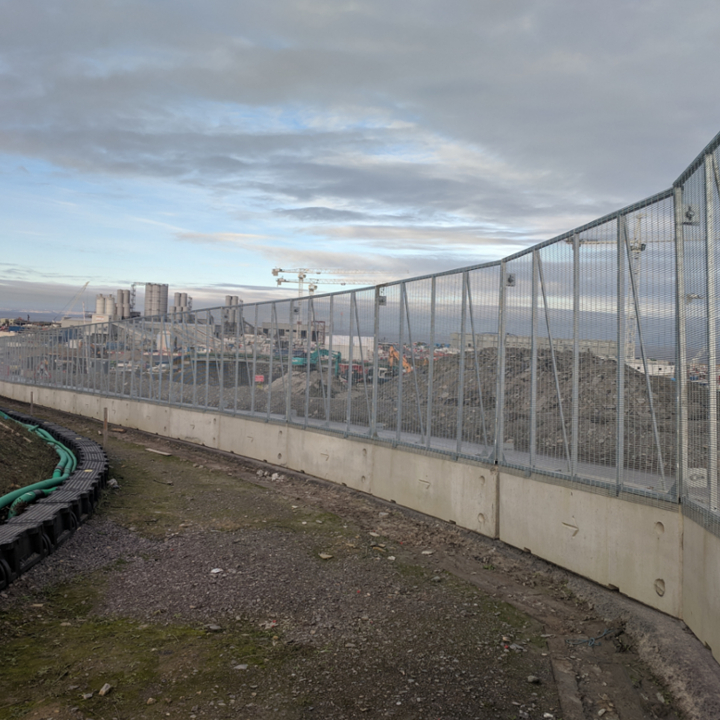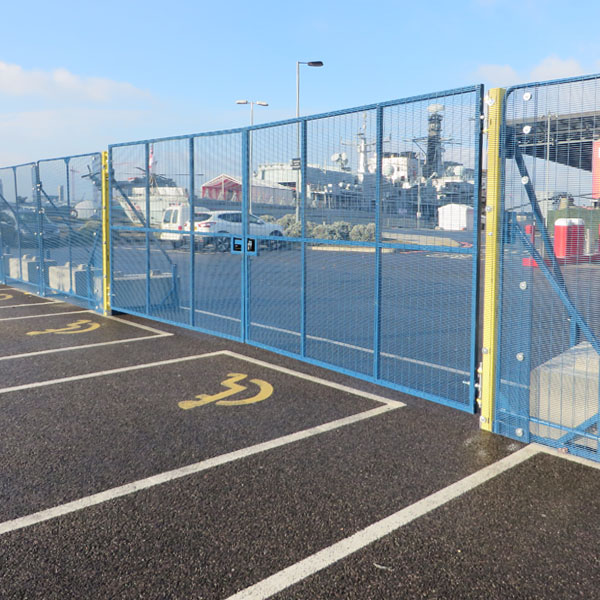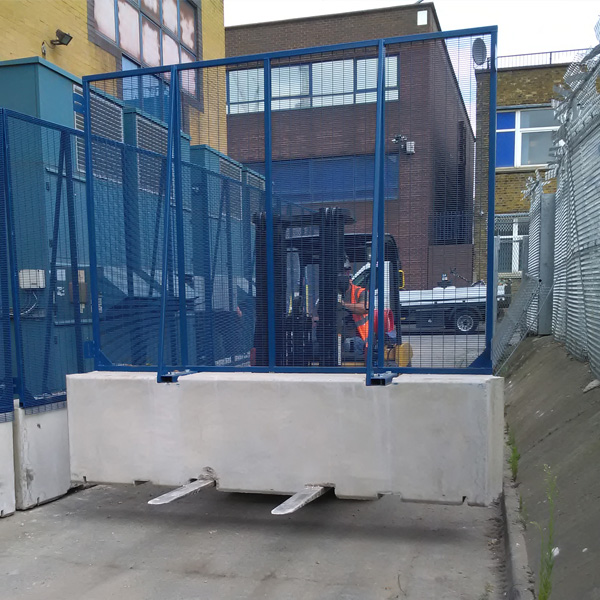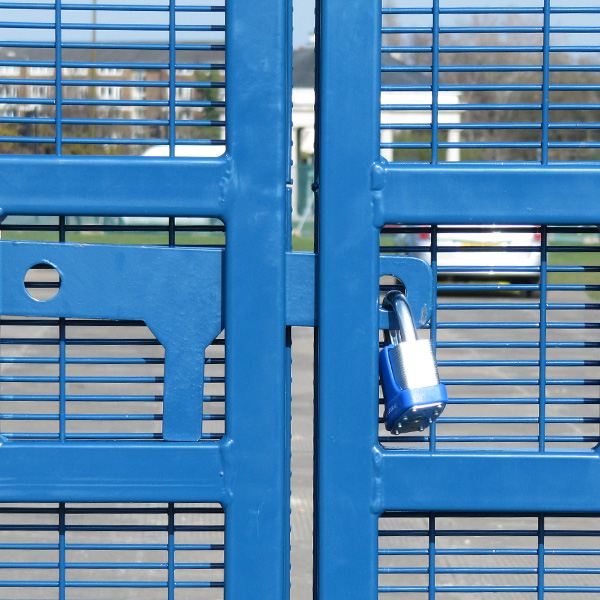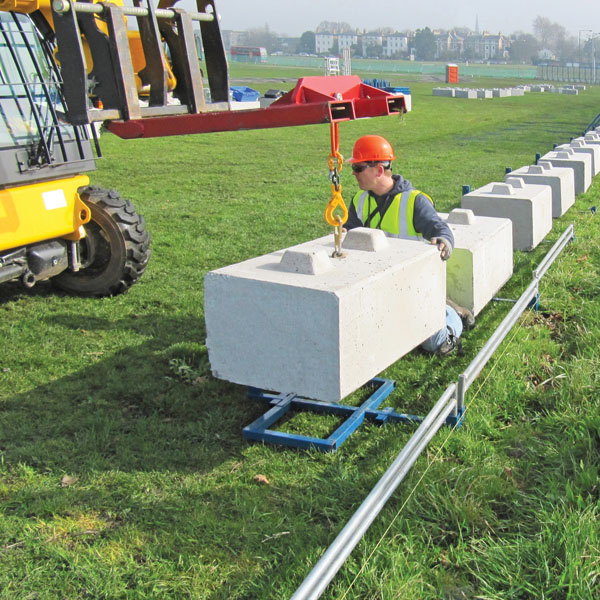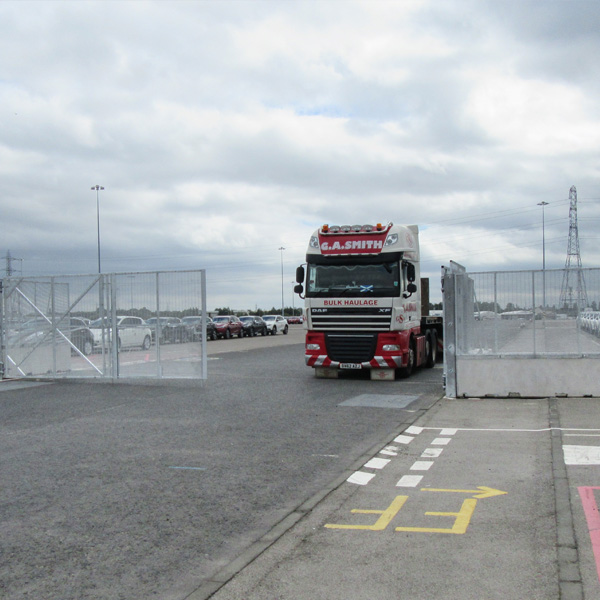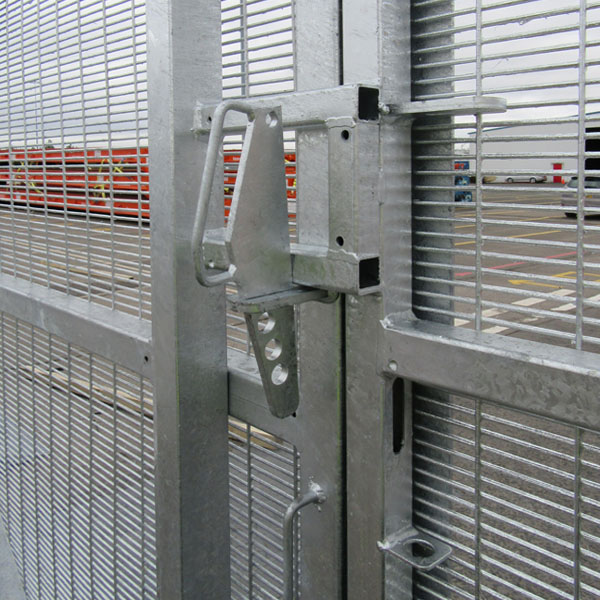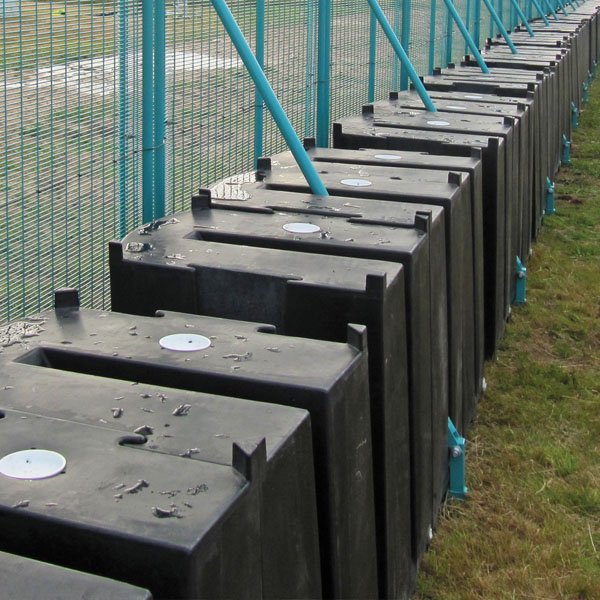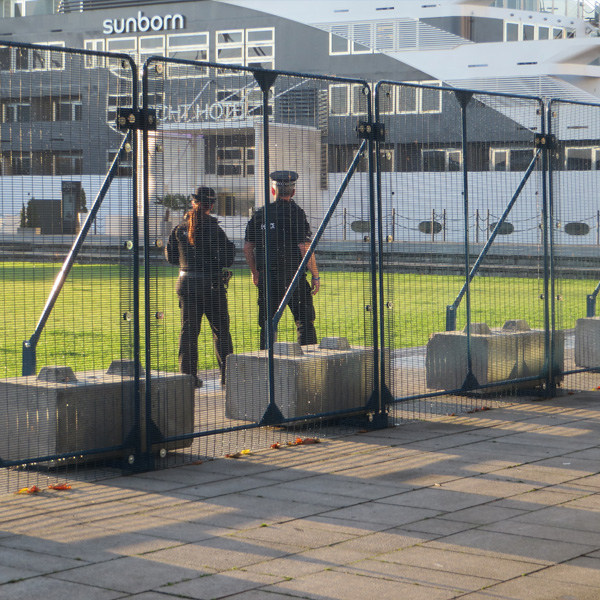Nuclear Engineering International Editorial
Nuclear facilities present a variety of challenges and obstacles when installing perimeter protection. The essential due diligence required imposes timely and costly impediments to securing the facility in need. In addition, with contaminated land, there are further requirements to dispose of the land and materials effectively which again presents further timely and costly barriers. POLMIL® systems are designed to address these challenging issues by providing On-Ground solutions for perimeter protection. The benefits situated consist of:
- Avert damaging underground services.
- Improve ability to expand or contract boundaries at will.
- CPNI assessed to PAS68 standard
- Remove the need to dig and dispose of contaminated land and materials.
- Improve speed of installation and dismantle.
Specialising in the design and manufacture of temporary security fencing, Blok N Mesh UK Ltd has developed an on-ground fence system to meet the demanding security requirements of the nuclear industry, bringing a reduction in the administrative delays and physical installation risks associated with traditional post-in-ground fencing. They discuss the product and its uses with NEI.
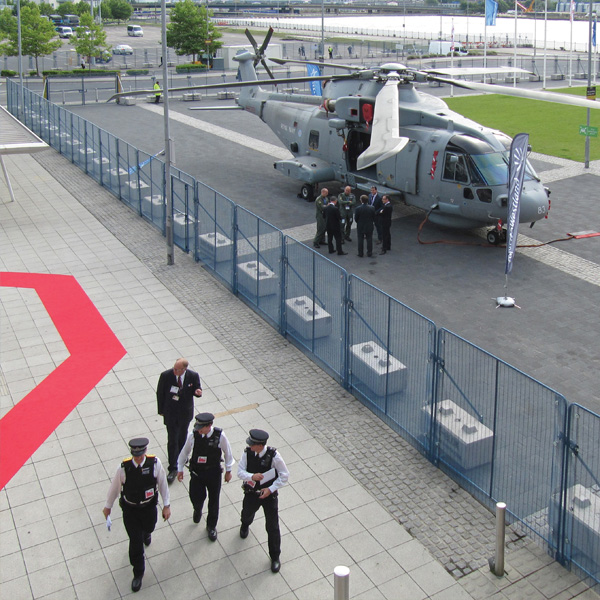
Part of a family-owned group of British companies founded in 1969, Blok N Mesh provides a range of steel hoarding, temporary fencing, demarcation and pedestrian barriers from its primary manufacturing plant set on a five-acre site in Merseyside, North West England. The Liverpool-based company distributes via their own network of hire and sale depots across the UK, Ireland and mainland Europe. “We are the only national company to solely specialise in the design, manufacture, hire and sales of temporary fencing, and pride ourselves on regularly bringing new and innovative solutions to the industry,” says Tim Stewart, product development director. “The on-ground security fence systems that we have become so expert in, is a completely different science to traditional post-in-ground fencing” Stewart set up the original temporary fence manufacturing facility in Liverpool and has been involved in all aspects of temporary fencing and hoarding ever since, including design, development, manufacture, storage, handling, transportation, installation, dismantling, hiring and selling.
What is POLMIL®?
Every installation presents a fence line with different challenges and obstacles to overcome. The modular POLMIL® system is sufficiently flexible to maintain its integrity whether deployed on undulating farm land, angular urban streets or even sandy beaches. The basic components comprise: a fully framed round top panel to minimise deflection, with lockable zero trip base, fully adjustable brace supports and ultra-wide cover mesh to protect panel joins. This configuration allows the fence panels to be held vertical even when traversing sloping ground. On-ground stabilisation of the system is provided by a choice of independent ballast options using concrete or water. This means the most appropriate ballast can be selected to suit each site’s specific requirements and environmental considerations. The counter-terrorist specification presents a formidable climbing obstacle to would-be intruders, and using heavy duty 358 Prison weldmesh prevents any significant ‘passthrough’ or ‘pass-under’ risk. POLMIL® systems have been tested, utilised, and proven compatible with leading CCTV and Perimeter Intruder Detection Systems (PIDS) on multiple global event venues. “Whilst forming an effective deterrent – the POLMIL® system is also aesthetically pleasing, quick and easy to install, replace, adapt, and 100% sustainable. Furthermore, the standard powder-coated finish means it can be coloured to promote corporate image or simply enhance the overall ‘look and feel’ of a venue,” the manufacturer says.
The company’s POLMIL® range of counter terror fencing was originally designed to meet stringent security requirements for the many varied London 2012 Olympic venues and was also selected to protect the Glasgow 2014 Commonwealth Games. More recently it has come to the attention of the nuclear industry. “With ‘no dig’ policies becoming the norm for temporary events and sensitive sites, the on-ground POLMIL® fence offers the same level of security as equivalent inground systems, and maintains the ability to reliably host micro-phonic perimeter intruder detection systems (PIDS),” says Stewart. The product’s modular design incorporates 30 years of temporary fencing experience and innovations which have resulted in the fence’s systems being exceptionally versatile and equally effective on soft undulating rural grassland or hard urban surfaces. Significant benefits the company says this product can offer to nuclear facilities include:
– Time saving: from the point of identifying a project need for security fencing, there are multiple administrative procedures and assessments, by a wide range of different specialists, that have to be completed before installers can start digging post holes in the ground at nuclear facilities. These cover concerns such as risk to underground services (existing and planned), environmental hazards (existing ground contamination, safe spoil disposal, making good when fence removed), future site changes (will the fence need to be moved/relocated at a later date). By the time all stakeholders have completed approvals, the very reason for the fence in the first place can be delayed as a result of the security fence not being in position by the planned project start date. The approvals required before installing on-ground relocatable security fencing are significantly less demanding and time consuming than those with post-in-ground.
– Cost reduction: the reduced number of administrative processes, meetings and expert assessments necessary before approval for on-ground fencing provide a significant cost saving in man-hours over traditional in-ground systems.
– Less risk: as with most industries – nuclear sites are all about reducing risk. Quite simply on-ground security fencing carries less associated risk than in-ground equivalents.
– Flexibility and sustainability: if circumstances change – as they often do – onground fencing is quick and easy to relocate, and 100% reusable.
Whilst using on-ground fencing reduces risk for the installers, it must also achieve at least the same level of security as the comparative post-in-ground alternative. “POLMIL® fence systems have been independently assessed, and catalogued, by the Centre for Protection of National Infrastructure (CPNI),” says Stewart. CPNI is the UK government authority for protective security advice to the national infrastructure. Their role is to protect national security by helping to reduce the vulnerability of the national infrastructure to terrorism and other threats.
Over and above the real life experience of successful multiple deployments at London 2012 and the Glasgow Commonwealth Games, specific testing has included long-term installations in harsh weather environment to confirm micro-phonic PIDS suitability, specialist forces attack, hostile vehicle ramming and coordinated ‘mob’ attack. “CPNI assessed BASE Level and PAS68 Rated versions are available for hire or sale,” says Stewart, describing the pedigree and accreditation of the POLMIL® on-ground fence offering.
Another challenge associated with nuclear site deployments is the highly corrosive atmospheric conditions that are a constant feature at these exposed coastal locations. Following initial trials at EDF’s Sizewell B and for longer periods at Hinkley Point C power stations, the company has developed a hot dipped galvanised after manufacture finish option for their POLMIL® fencing in order to maintain the aesthetic appearance, and significantly extend the working life of all major steel components exposed to these exceptionally harsh marine environments. The original trial at Sizewell B utilised POLMIL® systems as part of an upgrading programme to their existing fence line. The contractors used 100 linear metres of POLMIL® BASE level fence to protect the section of permanent fencing they were working on. The relocatable fence was simply moved along the line as the work progressed. This ensured the site maintained the appropriate level of security for the period that each section of permanent fence was compromised.
Each 750kg concrete kentledge block used for the fence has a 120 year design life and has seen considerable efforts being undertaken with regards to environmental concerns. The 50 Newton concrete ‘SafeBlok’ is been manufactured using 60% quarry dust (an industrial by-product) to minimise environmental impact, and does not contain reinforcement – making it much simpler to recycle. A central pin, recessed in the top of the Safe-Blok, provides a facility for lifting from above which enables the forklift to accurately position the kentledge from any angle. This assists more efficient installation, and is particularly helpful when physical obstacles near to the fence line restrict manoeuvrability.
Other developments include a unique alternative ballast method using water instead of the standard 750kg concrete blocks. This was invented for use on sites of special scientific interest, surfaces that could not support machinery, or those with only pedestrian access. Bespoke water ballast tanks are rotationally moulded from recycled plastic and enable on-ground fencing to be installed without mechanical lifting, as each tank can be manually carried to the fence line and positioned, then filled with water from a local source or distant lorry tanker. Water was the ballast of choice for a 4km deployment of this fencing in 2013 to protect a remote mining operation on an environmentally sensitive mountain in Greece, to mitigate the constant security risk from hostile protesters, whilst also complying with a strict ‘no dig’ policy imposed by the local authority.
The many features of the fencing range were underscored when the manufacturer won the Queen’s Award for Enterprise (Innovation Category) 2016. These are one of the UK’s most prestigious business awards, given only to companies or individuals who are outstanding in their field. Winners have demonstrated their business has substantially improved in areas of performance and commercial success by continuous innovation and development over at least a five year period. Innovation achievements are assessed for invention, design or production; performance of services and products, marketing and distribution. Following the reception at Buckingham Palace, and in reply to receiving the royal Grant of Appointment and Emblem, managing director of Blok N Mesh Laurence Payne said: “This is a tremendous achievement by everyone who has been involved in the POLMIL® project. For this success to now be recognised by Her Majesty the Queen is truly special and one that I am incredibly proud of.”
“I was based in Greece, where the company were having a particularly difficult time with terrorist activity and violent demonstrations a daily occurrence. To make matters worse, the local planning department refused to sanction permits for us to erect ‘normal’ fencing around the main site that we are building, exacerbating the security problems immeasurably. Fortunately I was made aware of Blok N Mesh UK Ltd and their ingenious on-ground fencing solutions, which we were able to use without any official sanctions. The POLMIL® fencing has now been in place almost two years, it has stood up to some extremely violent activity, including ram-raids and hostile crowds of up to 300 persons trying to pull fencing and gates down. The design quality shines through. This is all the more evident considering the extremely testing terrain on which we had to erect the fencing, again proving what a superb product this is. I can honestly say that without POLMIL®, it is highly unlikely that the Greek element of the Eldorado Gold mining operation would have been able to continue as it is today. They are a credit to themselves and to British innovation and service.
Martin Derbyshire
Security Manager, Eldorado Gold (Greece)
The company adds: “Since POLMIL® has continued evolving at the Merseyside factory with the introduction of a 10m wide on-ground gate. Bi-folding leafs minimise the swing radius to allow safer operation and less vulnerable to being damaged when open. Multi-adjustable hinges and unique locking mechanisms are designed to remain operational even when heavy vibration or ground movement cause the repositioning of one gate leaf relative to another over time.” Stewart explained: “A number of customers were looking for a means of access through the fence line for ‘monster machines’ such as the 110 ton dump trucks commonly used for mining operations and nuclear new build sites. In keeping with POLMIL® philosophy – the relocatable posts supporting these 10m gates are completely surface mounted and highly tolerant of different ground conditions.”


